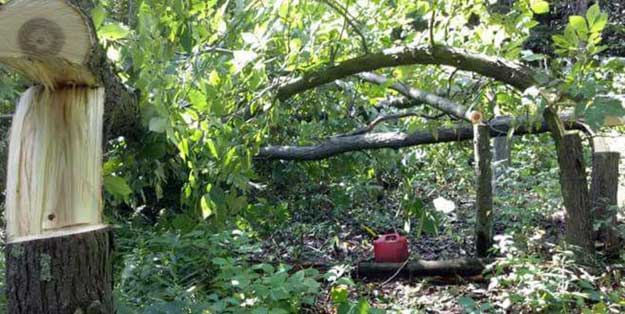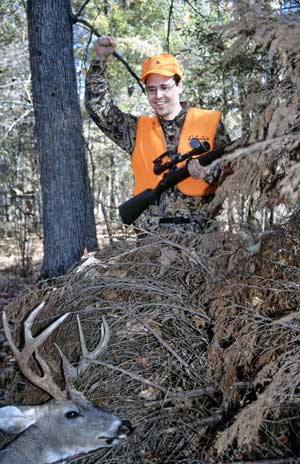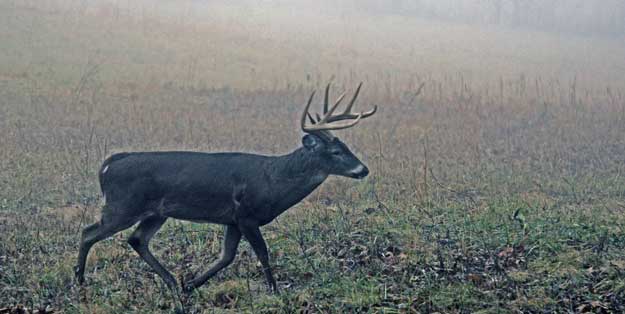Benny Collins | Mossy Oak ProStaff

We practice hinge cutting, the process of cutting trees with no economic value and letting the tops of those trees fall over, on quite a few of the farms where we plant green fields. Hinge cutting makes open areas thicker and creates feeding, bedding and cover for deer. Hinge cutting also enables mast-producing trees to get more nutrients and water to produce more acorns and soft mast for the deer.
To hinge cut non-valuable trees, we use a chainsaw and cut into the tree, but we don’t cut all the way through the tree. We use a wedge like one you use to split logs, and we drive that wedge into the cut that we've just made on the tree with the chainsaw. As we drive the wedge into the tree, the top part of the tree falls over but doesn’t break off. So the top of tree is on or near the ground, and the deer can get to those new leaves in the upper half of the tree and feed on them. You’ve also created a brush shelter that the deer can walk under and bed under for many years. If you hinge-cut trees along a property line, your neighbors can’t see into any green fields that you may have on the edges of the property line. You're not only providing food, cover and sanctuary for the deer on your land, but also for the older-age-class bucks that hunting pressure drives off your neighbor’s property onto yours.
When I first started hinge cutting, we had about two acres of property on the side of a hill that had a tremendous amount of sweetgums and other undesirable trees and provided no cover for deer. On that place, I hinge cut a lot of trees, so the tops fell in toward each other and created big brush shelters for deer. I wanted my trees to fall so that the tops were barely touching the ground, and the trunks of the trees were still attached to the tops that had fallen over. Immediately, after we hinge cut this area, we started seeing deer move into the region feeding on the tops of these trees that were laying over.
Using this form of cutting, the tree will stay alive for several years and put on new branches and new leaves every year. By cutting a good number of trees in the same section of land, the limbs from one hinge-cut tree will support the tops of other trees that are hinge-cut close to it. So, the deer can walk between the stump and the top of the tree that’s laying over. They can feed on the leaves and the new branches. They also can bed and be out of the weather under those tops.
 One year, after hinge cutting that 2-acre hillside, I took a really big 10-point buck from there where we’d never seen a buck before. We had trail camera pictures of deer moving through that area at night but never in daylight hours before we started hinge cutting. After hinge cutting, we began to see quite a few bucks there during daylight hours.
One year, after hinge cutting that 2-acre hillside, I took a really big 10-point buck from there where we’d never seen a buck before. We had trail camera pictures of deer moving through that area at night but never in daylight hours before we started hinge cutting. After hinge cutting, we began to see quite a few bucks there during daylight hours.
Another way that I use hinge cutting is to cut a line of non-valuable trees that lead up to one of our food plots. This way, the deer have cover and bedding sites close to their food. They can walk under those hinge cut trees and not be seen until they step out into the green field.
Explain what you’re going to do and how you're going to use hinge cutting to the landowner. You have to explain that you’re not going to cut any trees that he can use for timber. Then you can show the landowner the hinge cut areas that you’ve created, and he can understand how hinge cutting helps his timber grow better, and how the hinge cut areas provide more food and cover for deer.
I usually hinge cut in February, but I have done some hinge cutting before and during deer season. Oftentimes we’ll put up a trail camera where we’ve hinge cut several trees. Usually by the next morning, we've got pictures of deer feeding on the leaves and branches of the tops that have fallen over.
Before you cut any trees, determine your hinge cutting strategy. The GameKeepers at Mossy Oak can assist you in determining how and what to cut for keeping deer on your property.



























